Antique CIVIL War 1864 $50 Ny Treasury Note CDV Photo Counterfeit Naramore Ct
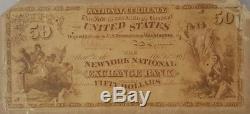
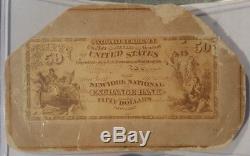
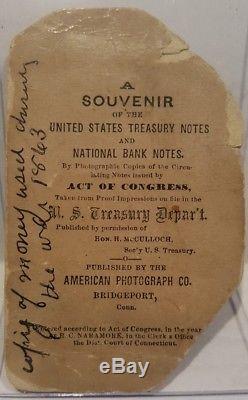
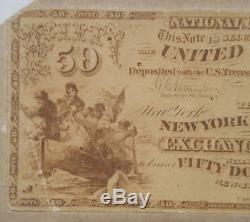
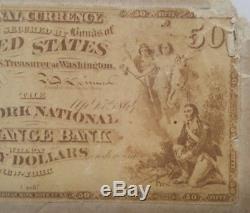

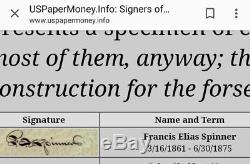
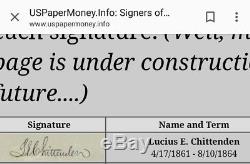
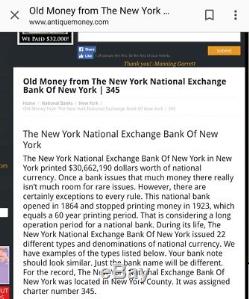
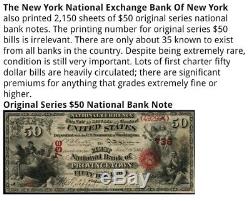




An original CDV photograph patented by R. Naramore of CT of a 1864 fifty dollar treasury note published for anti counterfeit purposes (and other purposes such as business and advertising) measuring approximately 3 7/8 x 2 3/8 inches. See some great information on the background of these and similar business cards and signers of the currency and the authorizer of the photo below. Other pictures for reference only. New York Photographer: Legal Tender Business Cards By Fred Reed, Coins Magazine July 15, 2013 This article was originally printed in Coins Magazine.
Last fall I added the item shown this month to my collection, and I was excited to get it. Not only is it a Lincoln item, and I gravitate toward Lincoln images, but it is also linked to my interest in anti-counterfeiting measures, about which I wrote several hundred thousand words published in this periodicals sister publication Bank Note Reporter over the years.
It also dovetails my interest in photographic history. It was also previously unknown to me and also to every other expert who I could wrangle an opinion out of. This slightly larger than CDV-sized calling card was printed and circulated by a 19th-century New York City photographer. Some readers may already have noticed that it bears resemblance to the Naramore Souvenir United States Treasury Note and National Bank Note cards that bore approved photographic copies of the circulating notes issued by Act of Congress, taken from proof impressions on file in the U. These were issued as a 18-note card deck or mounted on a wall poster to assist bank tellers and merchants in determining whether the notes passing through their change drawers were legitimate or counterfeit bills.
Incredibly, Naramore, an enterprising Connecticut entrepreneur, secured a patent on these one-fourth size reproductions of real currency on July 19, 1866, and also permission to publish them from U. Treasury Secretary Hugh McCulloch 11 days later. Naramores cards were printed in New York City by Maverick, Stephen & Co.
And published and copyrighted by the American Photograph Co. I have made a concerted study of these items as part of my interest in counterfeiting in the Civil War era, as have other collectors. All Naramore cards are scarce and highly prized.
We know that some very rare Naramore cards bear the additional imprint of a New Haven, Conn. Tailor by the name of T[homas] Hurle on the face of the Naramore cards.
HURLE, Merchant Tailor, 448 Chapel St. He advertised Gents First Class Garments Made to Order in the Best Style, and Gents Furnishing Goods, and Canes and Umbrellas.
The Hurle cards are about as rare as hens teeth, however this new G. Thorne card is completely new to the literature and may, in fact, be unique. So who was this Thorne guy and whats his story? New York City picture dealer George W.
Thorne had a shop at 60 & 62 Nassau St. 22, 1863, meeting the Board of Aldermen OKed the 21-year-old Thornes request to place a sign in front of his place of business. From 1863 to 1879, he dealt in photograph albums, cartes de visite, stereoviews, stereoscopes and similar products. According to photographic historians his list of stereoviews numbered more than 4,000 different images. Especially prominent are his American Views, including scenic views of subjects such as Niagara Falls, Saratoga Springs, the Green Mountains, and Washington, D. My favorite is his very rare view of people perched in a tree to view Lincolns funeral procession in New York City as the national saviours casket made its way back to Springfield, Ill. The card photograph illustrated here served as his business card. That published the anti-counterfeit card photographs. Thorne died June 29, 1900.He was 58 years old at the time, living at the citys residential Mills Hotel. It is not known that Thorne received U. Treasury permission for this style of card, nor is it apparent that Naramore licensed his patented card photograph to Thorne. Thus is appears that Thorne saw a Naramore card and pirated it for his own purposes.
Its doubtful that he copied many denominations of the series. Thus the card is still somewhat of a mystery, but a delectable and undoubtedly rare one at that. Spinner Francis Elias Spinner (January 21, 1802 December 31, 1890) was an American politician from New York. He was Treasurer of the United States from 1861 to 1875. He was the first administrator in the federal government to employ women for clerical jobs.
Spinner10th Treasurer of the United StatesIn office March 16, 1861 July 30, 1875PresidentAbraham Lincoln Andrew Johnson Ulysses S. House of Representatives from New York's 17th districtIn office March 4, 1855 March 3, 1861Preceded byBishop PerkinsSucceeded bySocrates N. ShermanPersonal detailsBornJanuary 21, 1802 German Flatts, New York, U. DiedDecember 31, 1890(aged 88) Jacksonville, Florida, U. Resting placeMohawk Cemetery Mohawk, New YorkParentsJohn Peter Spinner Mary Magdalene Fidelis Brument SpinnerSignature LifeEdit His father was John Peter Spinner (born in Werbach, Baden, 18 January 1768; died in German Flatts, NY, 27 May 1848), a Catholic priest who became a Protestant, married Mary Magdalene Fidelis Brument, [1] emigrated to the United States in 1801, and was pastor of two German-speaking Dutch Reformed churches, [2] at Herkimer and German Flatts until his death.
Francis Spinner was the eldest of nine children, six sons and three daughters. His father instructed him in languages, and in the common schools of Herkimer County he learned English grammar, reading, writing and arithmetic. His father required Spinner to learn a trade. Francis elected to become a merchant, and for about a year was employed as a clerk in a store.
The store failed, and Francis was apprenticed to a confectioner in Albany. [3] In Albany, Spinner made the acquaintance of some educated men who took an interest in his welfare. Peter Gansevoort allowed him the use of his library. Two years after his arrival, when his father found he was being employed as a salesman and bookkeeper, Spinner was removed from that situation and apprenticed to a saddle and harness maker in Amsterdam, New York. Here Spinner became a shareholder in the circulating library, and studied its volumes when he wasn't busy learning his trade.[3] In 1824, Spinner moved back to Herkimer County, where he engaged in mercantile pursuits. In 1826, he married Caroline Caswell of Herkimer.
[1] He entered the state militia, and by 1834 had risen to the rank of major general. He was appointed deputy sheriff in 1829, and was sheriff of the County from 1834 to 1837.
He was appointed one of the commissioners for the construction of the state lunatic asylum at Utica, New York in 1838. When he was removed from this post on political grounds, he engaged in banking, first as cashier and later as president, at the Mohawk Bank. He was state inspector of turnpikes, and served as commissioner and supervisor of schools. He was appointed auditor and deputy naval officer in charge of the Port of New York in 1845 and served four years. Spinner was elected as an anti-slavery Democrat to the 34th Congress.
An active Republican from the formation of the party, he was re-elected as a Republican to the 35th and 36th United States Congresses, altogether serving from March 4, 1855, to March 3, 1861. He served on the Committee on Privileges and Elections, on a special committee to investigate the assault made by Preston Brooks on Charles Sumner, and on a conference committee of both houses on the Army appropriation bill, which the senate had rejected on account of a clause that forbade the use of the military against Kansas settlers.
During his last term (36th Congress), he was chairman of the Committee on Accounts. Fifty-cent Fractional Currency depicting Spinner, with autograph signature.
On the recommendation of Secretary of the TreasurySalmon P. Chase, he was appointed by President Lincoln as Treasurer of the United States and served from March 16, 1861, until his resignation on July 1, 1875.Within 60 days of his assuming office, the expenditures of the federal government increased dramatically. [1] He was the first to suggest the employment of women in government offices. During the Civil War, many of the clerks of the Treasury Department joined the army, and Spinner suggested to Secretary Chase the advisability of employing women. After much persuasion, [4] his suggestion was taken up, and he carried it into effect successfully, though not without much opposition.
[1] He eventually hired over 100 women, paid them well, and retained them after the war was over. [2] Spinner's signature on an 1862 issue United States Note.
His signature on the greenbacks of the United States was the most familiar autograph in the country. The history Spinner gave of his signature was: I first practiced it while in the sheriff's office about 1835; I used it while commissioner for building the asylum at Utica, and as cashier and president of the Mohawk valley bank, and for franking while in congress.
It was brought to its highest perfection when I was treasurer. [5] He resigned his office because of a disagreement over staffing appointments.
A new Secretary refused to give him final say over his staff. Spinner thought that, as a bonded officer, he should have control over the appointment of clerks for whose acts he was responsible.
The result showed a very small discrepancy, and many days were spent in recounting and examining the books of accounts, until finally the mistake was discovered. In 1875, he ran on the Republican ticket for New York State Comptroller but was defeated by Democrat Lucius Robinson. He moved south, and for some years he lived in camp at Pablo Beach, Florida, where he lived a vigorous outdoor life, [2] and also took up the study of Greek. [5] He was survived by one of his three daughters. [5] He was buried at the Mohawk Cemetery, in Mohawk, New York.
Chittenden Lucius Eugene Chittenden (May 24, 1824 July 22, 1900) was a Vermont author, banker, lawyer, politician and peace advocate who served as Register of the Treasury during the Lincoln administration. Lucius Eugene ChittendenMember of the Vermont Senate from the Chittenden County districtIn office 18561860Register of the U.TreasuryIn office April 17, 1861 August 10, 1864Preceded byNew positionSucceeded byStoddard B. ColbyPersonal detailsBornMay 24, 1824 Williston, Vermont, U. DiedJuly 22, 1900 (aged 76)Resting placeLakeview Cemetery, Burlington, Vermont, U.
Lucius Chittenden received his early education in the district schools of Williston and academies in Williston, Hinesburg and Cambridge. He studied law with several attorneys, and was admitted to the bar in Franklin County in 1844.
He opened a law office in Burlington the next year. PoliticsEdit He became interested in politics and public affairs early in his career, gained prominence in the anti-slavery movement and the Free Soil Party, and published from 1848 to 1851, with E.Stansbury, the Free Soil Courier. Robinson get elected governor in 1852, he became active in the newly formed Republican Party. He was elected state senator from Chittenden County, and served from 1856 to 1860, while also serving as president of the Commercial Bank in Burlington. Civil WarEdit In February, 1861 Governor Erastus Fairbanksappointed Chittenden one of five Vermont delegates to the Washington Peace Conference, which met to try avert the start of the American Civil War. The other delegates were former Governor Hiland Hall, Levi Underwood, Horace Henry Baxter, and Broughton Harris.
Chittenden was selected as recorder of the conference, and published its records in 1864. In March 1861, President Lincoln's new Secretary of the Treasury, Salmon P. Chase, who had also been a member of the Free Soil Party, offered Chittenden the position of Register of the U. Chittenden accepted, and served for most of Lincoln's first term until resigning in 1864 due to poor health. During his term at the Treasury Department, Chittenden attracted notice when he worked to the point of exhaustion in order to ensure that a bond issue required to finance the Union war effort could be issued on time.Chittenden injured his hand and wrist in this work, which prompted him to resign as Register. [1][2] Chittenden was also credited with bringing to Lincoln's attention the case of William Scott, a Vermont soldier sentenced to death for sleeping on guard duty, and for whom Lincoln interceded by issuing a pardon. The event became part of Lincoln lore as the story of The Sleeping Sentinel, and Chittenden later published his account of the event. [4] He was buried at Lakeview Cemetery in Burlington.
[5] FamilyEdit Chittenden was married to Mary Hatch in 1856, and she died in 1894. They were the parents of three children: Horace H. Became an attorney in New York City; Mary H. Was the wife of William Bradford and a resident of Burlington; and Bessie B. Frederick Richards of New York City. [6][7] WritingsEdit "Address before the 34th Reunion of the Reunion Society of Vermont Officers, November 5, 1897, " at Bennington, Vermont. Proceedings of the Reunion Society of Vermont Officers Vol. New Moneys of Lincoln's Administration. Their Origins, Growth, and Value. New York: Richmond, Croscup & Co. Invisible Siege: The Journal of Lucius E. Chittenden April 15, 1861 July 14, 1861.Lincoln and the Sleeping Sentinel The True Story. New York: Harper & Brothers, 1909.
Personal reminiscences, 18401890, including some not hitherto published of Lincoln and the war. Recollections of President Lincoln and his Administration. New York: Harper and Brothers.
Rutland, VT: Tuttle & Co. "The Character of the Early Settlers of Vermont Its Influence upon Posterity, " delivered July 4, 1876, at Burlington, Vermont. Contained in Our National Centennial Jubilee: Orations, Addresses and Poems Delivered on the Fourth of July, 1876. Clair Shores, MI: Scholarly Press, 1976, pp.
The Law of Baron and Femme, of Parent and Child, Guardian and Ward. And of the Powers of the Courts of Chancery; With an Essay on the terms Heir, Heirs, and Heirs of the Body. Second Edition, with Notes, Burlington, VT: Chauncey Goodrich, 1846. A Report of the Debates and Proceedings in the Secret Sessions of the Conference Convention, for Proposing Amendments to the Constitution of the United States at Project Gutenberg, 1864.RELATED ARTICLES 3rd Vermont Infantry John L. Barstow American politician Urban A. Woodbury Governor of Vermont Hugh McCulloch This article is about the American statesman. For the American poet, see Hugh McCulloch (poet). For other meanings, see Hugh McCulloch (disambiguation).
Hugh McCulloch (December 7, 1808 May 24, 1895) was an American statesman who served two non-consecutive terms as U. Treasury Secretary under three presidents. He was opposed to the National Banking Act of 1864, and attempted to bring the United States back to the gold standard throughout his career. Hugh McCulloch36th United States Secretary of the TreasuryIn office October 31, 1884 March 7, 1885PresidentChester A. Arthur Grover ClevelandPreceded byWalter Q.
GreshamSucceeded byDaniel Manning27th United States Secretary of the TreasuryIn office March 9, 1865 March 3, 1869PresidentAbraham Lincoln Andrew JohnsonPreceded byWilliam P. BoutwellPersonal detailsBornDecember 7, 1808 Kennebunk, Maine, USDiedMay 24, 1895 (aged 86) Prince George's County, Maryland, USPolitical partyRepublicanAlma materBowdoin CollegeProfessionPolitician, Lawyer BiographyEdit Early lifeEdit Born in Kennebunk, Maine, he was educated at Bowdoin College, studied law in Boston, and in 1833 began practicing law at Fort Wayne, Indiana. He was cashier and manager of the Fort Wayne branch of the state chartered Bank of Indiana and President of the larger organization from 1835 to 1857, and president of its successor, the privately owned Bank of Indiana from 1857 to 1863. Despite his early opposition to the National Banking Act of 1862, he was selected by Salmon P. Chase to be the first Comptroller of the Currency in 1863.
[1] During McCulloch's 22 months in office, 868 national banks were chartered and no failures occurred. As the first Comptroller, McCulloch recommended major changes in the banking law and the resulting National Banking Act of 1864 remains the foundation of the national banking system.[2] Bank of IndianaEdit McCulloch began his banking career as the President of the Bank of Indiana. In 1833 the bank was established in response the closure of the Second Bank of the United States.
Indiana was still a wilderness and no eastern bank was willing take charge of the fledgling state bank. McCulloch was one of the few prominent businessmen in the young state, and although he had no banking experience, he was appointed because he was the most qualified person willing to take the position. He ran the bank with great efficiency making it one of the most stable in the nation. He remained president until the bank was closed in 1859 and the bank's notes were exchanged for federal notes from the new national bank.
He then went on to become president of the Second Bank of Indiana, where he remained until 1865. Government careerEdit Bureau of Engraving and Printing portrait of McCulloch as Secretary of the Treasury. On March 9, 1865, McCulloch was appointed as the 27th Secretary of the Treasury by President Abraham Lincoln. [1] His appointment was largely due to his influence with existing state banks.
McCulloch later remarked that on the morning of Lincoln's assassination, I never saw Mr. Lincoln so cheerful and happy... The burden which had been weighing upon him for four long years, and which he had borne with heroic fortitude, had been lifted; the war had been practically ended; the Union was safe. [1] He continued to serve in the Presidential Cabinet of Andrew Johnson until the close of his administration in 1869.Immediately confronted with inflation caused by the government's wartime issue of greenbacks, he recommended their retirement and a return to the gold standard. [2] In McCulloch's first annual report, issued on December 4, 1865, he strongly urged the retirement of the legal tenders or greenbacks as a preliminary to the resumption of specie payments. However this would have reduced the supply of currency and was unpopular during the period of postwar reconstruction and westward expansion.
The battle over its revival raged for the next fifty years. McCulloch was also disappointed by the decision of the United States Supreme Court upholding the constitutionalityof the legal tenders. During his tenure, McCulloch maintained a policy of reducing the federal war debt and the careful reintroduction of federal taxation in the South. Soon after the close of his term of office McCulloch went to England, and spent six years (18701876) as a member of the banking firm of Jay Cooke, McCulloch & Co.
From October 1884 until the close of President Chester A. Arthur's term of office in March 1885, McCulloch again served as Secretary of the Treasury. During his six months in office at that time, he continued his fight for currency backed by gold, warning that the coinage of silver, used by then as backing for currency, should be halted. [3] PersonalEdit He died at his home, Holly Hill in Prince George's County, Maryland, near Washington, D.
In 1895 and is buried in Rock Creek Cemetery in D. McCulloch Hall, a residence hall at Harvard Business School, was named in his honor. Revenue Cutter Service and its successor, the U. Coast Guard, each named cutters after McCulloch. The Revenue Cutter USS McCullochserved under George Dewey in the Battle of Maniladuring theishAmerican War, and Coast Guard Cutter McCulloch served in World War II and the Vietnam War.
The chief authority for the life of McCulloch is his own book, Men and Measures of Half a Century (New York, 1888). McCulloch was the last surviving member of the Lincoln Cabinet. His house at Fort Wayne, the Hugh McCulloch House, was listed on the National Register of Historic Placesin 1980. [4] References External links Last edited 4 months ago by InternetArchiveBot RELATED ARTICLES National Bank Act United States Note Office of the Comptroller of the Currency Content is available under CC BY-SA 3.0 unless otherwise noted.Terms of UsePrivacyDesktop Source: Wikipedia and its sources. The item "ANTIQUE CIVIL WAR 1864 $50 NY TREASURY NOTE CDV PHOTO COUNTERFEIT NARAMORE CT" is in sale since Tuesday, February 27, 2018. This item is in the category "Collectibles\Photographic Images\Vintage & Antique (Pre-1940)\CDVs". The seller is "theprimitivefold" and is located in Villa Park, Illinois. This item can be shipped to United States, Canada, United Kingdom, Denmark, Romania, Slovakia, Bulgaria, Czech republic, Finland, Hungary, Latvia, Lithuania, Malta, Estonia, Australia, Greece, Portugal, Cyprus, Slovenia, Japan, China, Sweden, South Korea, Indonesia, Taiwan, South africa, Thailand, Belgium, France, Hong Kong, Ireland, Netherlands, Poland, Spain, Italy, Germany, Austria, Israel, Mexico, New Zealand, Philippines, Singapore, Switzerland, Norway, Saudi arabia, United arab emirates, Qatar, Kuwait, Bahrain, Croatia, Malaysia, Brazil, Chile, Colombia, Costa rica, Panama, Trinidad and tobago, Guatemala, Honduras, Jamaica.
- Original/Reprint: Original Print
- Listed By: Dealer or Reseller
- Date of Creation: Pre-1950
- Photo Type: CDV
- Subject: Historic & Vintage
- Color: Sepia
- Framing: Unframed
- Size Type/Largest Dimension: Small (Up to 7")
- Region of Origin: US


